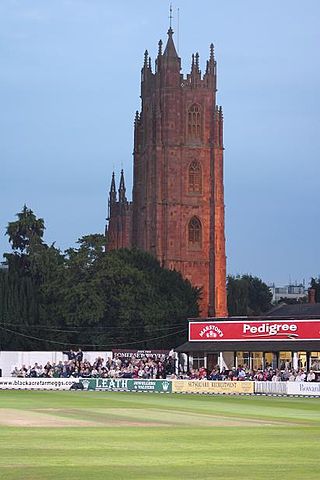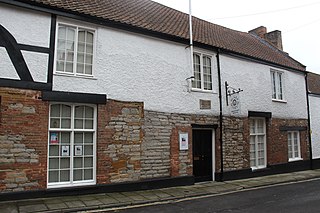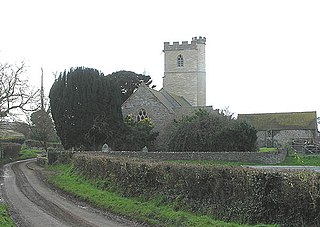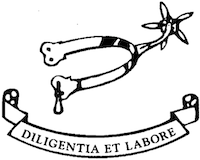
Somerset is a county in South West England which borders Gloucestershire and Bristol to the north, Wiltshire to the east, Dorset to the south-east and Devon to the south-west. It is bounded to the north and west by the Severn Estuary and the Bristol Channel, its coastline facing southeastern Wales. Its traditional border with Gloucestershire is the River Avon. Somerset is currently formed of six council areas, of which two are unitary authorities, until the four second-tier district councils are merged on 1 April 2023, after which the county will comprise three unitary authorities. Its county town is Taunton.

Bridgwater is a historic market town and civil parish in Somerset, England. The population was estimated at 41,276 in 2022. Bridgwater is at the edge of the Somerset Levels, in level and well-wooded country. The town lies along both sides of the River Parrett; it has been a major inland port and trading centre since the industrial revolution. Most of its industrial bases still stand today. Its larger neighbour, Taunton, is linked to Bridgwater via a canal, the M5 motorway and the GWR railway line.

The River Parrett flows through the counties of Dorset and Somerset in South West England, from its source in the Thorney Mills springs in the hills around Chedington in Dorset. Flowing northwest through Somerset and the Somerset Levels to its mouth at Burnham-on-Sea, into the Bridgwater Bay nature reserve on the Bristol Channel, the Parrett and its tributaries drain an area of 660 square miles (1,700 km2) – about 50 per cent of Somerset's land area, with a population of 300,000.

General at Sea Robert Blake was an English naval officer who served as the Lord Warden of the Cinque Ports from 1656 to 1657. Blake is recognised as the chief founder of England's naval supremacy, a dominance subsequently inherited by the British Royal Navy well into the early 20th century. Despite this, due to deliberate attempts to expunge the Parliamentarians from historical records following the Stuart Restoration, Blake's achievements tend to remain unrecognized. Blake's successes have been considered to have "never been excelled, not even by Nelson" according to one biographer.

Taunton is the county town of Somerset, England, with a 2011 population of 69,570. Its thousand-year history includes a 10th-century monastic foundation, Taunton Castle, which later became a priory. The Normans built a castle owned by the Bishops of Winchester. Parts of the inner ward house were turned into the Museum of Somerset and Somerset Military Museum. For the Second Cornish uprising of 1497, Perkin Warbeck brought an army of 6,000; most surrendered to Henry VII on 4 October 1497. On 20 June 1685 the Duke of Monmouth crowned himself King of England here in a rebellion, defeated at the Battle of Sedgemoor. Judge Jeffreys led the Bloody Assizes in the Castle's Great Hall. The Grand Western Canal reached Taunton in 1839 and the Bristol and Exeter Railway in 1842. Today it hosts Musgrove Park Hospital, Somerset County Cricket Club, is the base of 40 Commando, Royal Marines, and is home to the United Kingdom Hydrographic Office on Admiralty Way. The popular Taunton flower show has been held in Vivary Park since 1866, and on 13 March 2022, St Mary Magdalene parish church was elevated to the status of Taunton Minster.

North Petherton is a small town and civil parish in Somerset, England, situated on the edge of the eastern foothills of the Quantocks, and close to the edge of the Somerset Levels. The town has a population of 6,730 as of 2014. The parish includes Hamp, Melcombe, Shearston, Woolmersdon and Huntworth.

Ian Richard Peregrine Liddell-Grainger is a British Conservative Party politician and former property developer. He was MP for Bridgwater from 2001 until 2010, and since then has been MP for Bridgwater and West Somerset. He is a great-great-great-grandson of Queen Victoria through his mother.

Minehead is a coastal town and civil parish in Somerset, England. It lies on the south bank of the Bristol Channel, 21 miles (34 km) north-west of the county town of Taunton, 12 miles (19 km) from the boundary with the county of Devon and in proximity of the Exmoor National Park. The parish of Minehead has a population of approximately 11,981, making it the most populous town in the western part of the Somerset West and Taunton local government district, which in turn, is the worst area in the country for social mobility. This figure includes Alcombe and Woodcombe, suburban villages which have been subsumed into Minehead.

Wellington is a market town in rural Somerset, a county in the west of England, situated 7 miles (11 km) south west of Taunton in the Somerset West and Taunton district, near the border with Devon, which runs along the Blackdown Hills to the south of the town. The town has a population of 14,549, which includes the residents of the parish of Wellington Without, and the villages of Tone and Tonedale.

Shapwick is a village on the Polden Hills overlooking the Somerset Moors, in the Sedgemoor district of Somerset, England. It is situated to the west of Glastonbury.

Bridgwater Castle was a castle in the town of Bridgwater, Somerset, England.

The Blake Museum is in Bridgwater, Somerset, England at what is believed to be the birthplace of Robert Blake, General at Sea (1598–1657). Since April 2009 it has been run by Bridgwater Town Council with help from the Friends of Blake Museum. It has been an Accredited Museum since 2006. It is next door to the Bridgwater Town Mill, and there are plans to develop this as an extension of the museum.

Otterhampton is a village and civil parish in the Sedgemoor district of Somerset, England, between Bridgwater and the Steart Peninsula. The civil parish includes the larger village of Combwich and the small village of Steart.

Bridgwater and Taunton College is a further education college based in the heart of Somerset, England, with main centres in Bridgwater, Taunton and Cannington. It educates approximately 3000 students between the ages of 16–18 in academic and vocational programmes in addition to several thousand part-time or mature students. The college was founded in 1973, although the history of its predecessor institutions dates to 1891.

The Grade I listed buildings in Somerset, England, demonstrate the history and diversity of its architecture. The ceremonial county of Somerset consists of a non-metropolitan county, administered by Somerset County Council, which is divided into five districts, and two unitary authorities. The districts of Somerset are West Somerset, South Somerset, Taunton Deane, Mendip and Sedgemoor. The two administratively independent unitary authorities, which were established on 1 April 1996 following the breakup of the county of Avon, are North Somerset and Bath and North East Somerset. These unitary authorities include areas that were once part of Somerset before the creation of Avon in 1974.

Brymore Academy is a boys' secondary school with academy status, located in Cannington, Bridgwater, Somerset, England. It is a day and boarding school for pupils aged 11 to 17 years and had 192 boys on the roll in 2015, 115 of them boarders. It was established in 1951 by Somerset County Council at a cost of £6,000 as a Secondary Technical School of Agriculture.

Chilton Trinity School is a coeducational secondary school located at Chilton Trinity, Bridgwater, Somerset, England.

Bridgwater College Academy is a mixed all-through Academy which combines both primary and secondary education for pupils aged 3 to 16. The academy, which is sponsored by Bridgwater College, is located in Bridgwater, Somerset, England. It was established in September 2012 following the merger of East Bridgwater Community School with Sedgemoor Manor Junior and Infants schools.

Haygrove School is a co-educational secondary school in Bridgwater, Somerset, England, with 1,106 students aged between 11 and 16.

The Corn Exchange and market house in Bridgwater, Somerset, England was built in 1834 by John Bowen and extended in 1875, by Charles Knowles. It has been designated as a Grade I listed building.





















